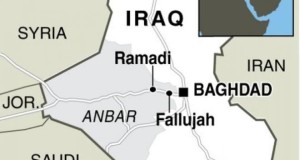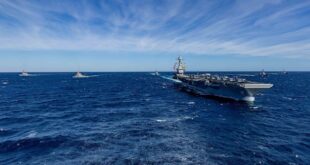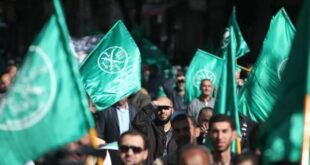The fall of Palmyra just after Ramadi emphasized the impression that ISIL regained the momentum, hence will help the organization recruit more fighters. Yet, the story of the fall of Ramadi is totally different than that of the fall of Palmyra.
The current ISIL offensives extends from Ramadi to Dair Al Zour to Central Syria. The group’s fighters are attacking the regime controlled airport in Dair Al Zour apparently to clear both West Iraq and East Syria of any other forces. ISIL’s control of Palmyra will enable the organization to have access to Eastern Qalamoun, the Reef of Damascus and Hems. Furthermore, Palmyra was an important point in the Iranian supply lines to the Syrian regime coming through Iraq.
But there is also an economic justification for this campaign. ISIL started its attack in May 13, seizing the two gas fields of al- Hil and al- Ark, the city of Al Sikhni and the village of al- Aamiriyyi. By controlling Al Sikhni, ISIL can cut the regime’s supply lines to the oil and gas rich regions around Shaer and Jezel enabling ISIL to attack them and control their lucrative resources. Selling antiquities to black market merchants proved to bring considerable financial gains to the organization. If not sold, these antiquities could be destroyed for propaganda gains among religious fanatics.
Therefore, the offensive is profitable to ISIL in terms of adding new fighters, new resources, new strategic location and new psychological ammunition to its propaganda arsenal.
But the fall of Ramadi has been different than that of Palmyra in one aspect at least. The story of Ramadi may have been intentionally written, not by ISIL, but by its adversaries in Baghdad.
For quite some time, extremist Shia political blocks in Baghdad worked under the conviction of a simple proposition: To arm Sunni tribes in order to fight ISIL is a mistake. ISIL does not represent a major threat to the Shia regions in Iraq which are well defended by militias and Iraqi security forces.
As these politicians sought to control Sunni land by force, the differences between an armed Sunni population and ISIL was not that substantial so far as both will resist this objective. They both have to be confronted and contained.
Depriving the Sunni Arab tribes of weapons to fight ISIL was based on that proposition and was a deliberate policy in Baghdad since US forces pulled out of Iraq. Freezing the National Guard law in the Parliament, freezing the Federal Regions as stated in the Constitution and freezing the General Amnesty Legislation were intentionally done against all kinds of pressure, particularly from the US. The sole objective of keeping Sunni regions helpless and dependent on Baghdad blurred, in the eyes of Iraq’s extremist Shia blocks, all the differences between the tribes and ISIL. That assumption helped ISIL since its start. In the current phase of the Iraqi situation, the objective of the extremist Shia forces and of their Iranian sponsors was to get the Shia militias into Anbar to fight ISIL and to avoid at all cost arming the Arab tribes to fight the organization as that will make them difficult to subdue afterwards.
Lately, this state of mind resulted in a stubborn opposition to any attempt by Prime Minister Haider Al Abadi to arm the Sunni tribes to fight ISIL particularly after the battle of Tikrit. But Abadi and the US seemed determined to prevent the militias from going to Anbar and to demand its transformation and integration, on individual bases, into Iraq’s security forces.
The two opposing arguments could not find a common ground. It was only the fall of Ramadi that will force Abadi and the Americans to reluctantly accept the position of the Iranians and their proxies in Iraq.
Therefore, in the case of the battle of Ramadi, and due to the mentioned context and to what happened in the count down to the city’s fall, there are multiple reasons that make one wonder if Ramadi was not deliberately left to ISIL in order to force Iraq’s government and the US to legalize the existence of the extremist Shia militias’ and accept their attack on Sunni land under the superficial cover of Iraq’s armed forces.
Examining what happened during the weeks that led to the fall of Ramadi shows that this setback may have been a calculated gamble by some Shia politicians, the militias and their backers in the Quds Brigade of the IRGC to achieve a far reaching political goal. Their assessment is that if Baghdad refused to send arms to the tribes of Anbar (Shia extremists in the government and Parliament can guarantee that), Ramadi would inevitably fall. That will end any opposition from moderate Shia forces in Baghdad and from the US to the role of the Shia extremist militias in Anbar and will get those who oppose the idea to even beg for sending the militias to Sunni land to stop ISIL.
We counted the number of times Anbar Sunni tribes, particularly in the Ramadi region, sent delegations to Baghdad to plea for arms and ammunitions since the difficult victory of the militias in Tikrit last month, to find out that on nine occasions, within one month, the tribes sent their representatives to Abadi to beg for equipment to confront ISIL in the Anbar. On all nine occasions they were promised that help is on the way. This help never materialized. The US could not send arms on its own as the relevant agencies are abiding by President Obama’s rule to send arms only through governments.
Looking at the video tapes of the collapse of Iraqi defenses in Ramadi shows that the elite Golden Brigade, relatively well armed, was forced to run when the 2,000-man police force just left their positions and fled the town with the first attack of ISIL. ISIL attacked the town with around 30 trucks loaded with explosives and driven by suicide bombers. One of the Golden Brigade men was cursing and openly accusing the police force of treason and collaborating with the enemy. The tribal force of around 1,000 men had to disband with the collapse of the defenses. They knew they would be slaughtered by ISIL.
The Federal Police force, which collapsed first, is known to be heavily infiltrated by Shia extremists. In fact, those extremists control the whole of the Ministry of Interior. The collapse of the police force was not surprising. It may fit well within the context of twisting Abadi’s and US arms to accept giving a primary role for the extremist militias in the war of Anbar.
When the Pentagon insisted on not fighting side by side in Tikrit with militias led by Iranian officers and receiving orders from Qassem Sullimani, a huge wave of anti-American propaganda started in Iraq. When the US insisted on working only with Iraq’s security forces under the command of Baghdad’s government, this position had to be dealt with through a shock like the fall of Ramadi to soften the opposition. The target was to use the impact of the fall of Ramadi to get all relevant parties to accept the participation of the militias in the war for Anbar, perhaps with only cosmetic changes on its legal status.
The changes in mind were based on a simple concept: Put the militias, only in appearance, under the flag of Iraq’s security forces to overcome the opposition of the US military. Furthermore, get Anbar’s political and tribal elite, threatened directly by ISIL, to publicly invite the Shia militias to enter the province and defend it against ISIL.
US personnel in Iraq knew very well that this cosmetic change would change nothing in terms of the content of the command structure of the militias or the Iranian connection to it. They however held their ground for as long as they could in refusing the participation of three particular armed Shia groups: Asayeb Ahlo Alhaq, the Badr Organization and Iraq’s Hezbollah. Yet, the shock caused by the fall of Ramadi helped to provide the last push in ending the US and Abadi’s resistance to the reflagging of the militias under the banner of Iraq’s security forces while keeping its structure intact. Changing the labels and widening the cosmetic operations a bit provided a face-keeping way out. Qassem Sullimani won the Russian Roulette game.
Anbar’s elite in the Province’s political structure and some tribal leadership were told that the fall of Ramadi is just a lesson they have to learn. No one will come to their help—neither the Americans nor the Arabs. They have to accept issuing an invitation, of their own will, for the Shia militias to go to Anbar, or else they would never again be able to go to their province. Ironically, the panicking tribal leaders even accused the US of placing Anbar in jeopardy by rejecting the militias’ role in the fight.
However, Sullimani’s move on the chess board of Iraq may backfire. For example, the Sunni tribes which are still fighting ISIL, successfully in fact, in Ameryat Al Fallujah are now afraid they will have to pay a price for their anti ISIL position. They refuse to let the Shia militias in, and they are faced with the usual deaf ears in Baghdad. ISIL tried several times to take that town but failed, but will the fall of Ramadi encourage the tribes of that area to reach a deal with ISIL?
If ISIL preserves its momentum, the tribal members who fought it will end up considering reaching a deal. It will appear better than being slaughtered or ending up as refugees trying in vain to find shelter in the nearby Baghdad. Security forces in Baghdad do not allow any Sunni refugees to enter the city for fear of ISIL infiltrators among them.
The problem with Sullimani’s concept is that it may steer the Sunnis to the ISIL camp “en gros”. While he might have seen the fight all along from a sectarian perspective, the essence of the conflict has a genuine national dimension. There are many Iraqi Shias opposed to Iran’s role in their country. Furthermore, Sullimani’s tactics will prolong the civil war in Iraq. He increases the risks of a having an Iraq torn between two sectarian identities, depleted of resources due to a perpetual war of attrition between its components, and suffering a chronic terrorism problem.
But in the immediate range, there is another kind of threat—that is, ISIL’s planned attacks on Habannyah airbase and allegedly on Karbala. While ISIL is preparing to attack the airbase, it is spreading the word that it will target Baghdad and Karbala at the same time. Reports from Iraq indicate that the most probable goal of the organization is Karbala and that ISIL will wage a big campaign of terror inside Baghdad in order to distract the security forces.
But looking closely at the nature of ISIL’s media campaign, one would tend to believe that the chatter about attacking Karbala is a misinformation tactic by ISIL and its supporters. For the most likely target is Baghdad and in particular the Abu Gharib section of the capital.
Ezzat Al Douri, Saddam’s fugitive deputy, recorded a speech a few days ago which seemed to contain several coded messages. The first was addressed to Saudi Arabia expressing a need for support, though indirectly. The second was a warning about the militias’ focus on Nukhaib region which is strategically located in terms of access to Karbala and Saudi Arabia alike. Yet, it might have been a deception tactic to reinforce the impression that the next target is Karbala while it is in fact Baghdad itself. It is worth a while to say here that a Saudi attempt to send arms to Anbar tribes, through Jordan, to defend themselves against both Sullimani’s militias in Iraq and ISIL was aborted on recommendations by the US to Amman to allow arms only through the Central government of Iraq. The Obama Administration bases this position on legal considerations.
If the fall of Ramadi has a message to send to all, it is that things in Iraq are not getting better.
 Geostrategic Media Political Commentary, Analysis, Security, Defense
Geostrategic Media Political Commentary, Analysis, Security, Defense





